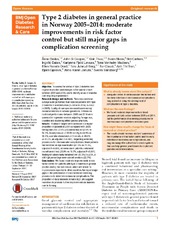| dc.contributor.author | Bakke, Åsne | en_US |
| dc.contributor.author | Thue, Geir | en_US |
| dc.contributor.author | Carlsen, Siri | en_US |
| dc.contributor.author | Dalen, Ingvild | en_US |
| dc.contributor.author | Skeie, Svein | en_US |
| dc.contributor.author | Løvaas, Karianne Fjeld | en_US |
| dc.contributor.author | Madsen, Tone Vonheim | en_US |
| dc.contributor.author | Oord, Ellen Renate | en_US |
| dc.contributor.author | Berg, Tore Julsrud | en_US |
| dc.contributor.author | Claudi, Tor | en_US |
| dc.contributor.author | Gjelsvik, Bjørn E. | en_US |
| dc.contributor.author | Tran, Anh Thi | en_US |
| dc.contributor.author | Jenum, Anne Karen | en_US |
| dc.contributor.author | Sandberg, Sverre | en_US |
| dc.contributor.author | Cooper, John Graham | en_US |
| dc.date.accessioned | 2018-03-02T12:03:27Z | |
| dc.date.available | 2018-03-02T12:03:27Z | |
| dc.date.issued | 2017 | |
| dc.Published | Bakke Å, Thue G, Carlsen S, Dalen I, Skeie S, Løvaas KF, Madsen, Oord ER, Berg TJ, Claudi T, Gjelsvik BE, Tran AT, Jenum AK, Sandberg S, Cooper JG. Type 2 diabetes in general practice in Norway 2005-2015: moderate improvements in risk factor control, but still major gaps in complication screening . BMJ Open Diabetes Research & Care. 2017;5:e000459 | eng |
| dc.identifier.issn | 2052-4897 | |
| dc.identifier.uri | https://hdl.handle.net/1956/17482 | |
| dc.description.abstract | Objective: To assess the status of type 2 diabetes care in general practice and changes in the quality of care between 2005 and 2014, and to identify areas of diabetes care requiring improvement. Research design and methods: Two cross-sectional surveys were performed that included patients with type 2 diabetes in selected areas (n=9464 in 2014, n=5463 in 2005). Quality of care was assessed based on key recommendations in national guidelines. Differences in clinical performance between 2005 and 2014 were assessed in regression models adjusting for age, sex, counties and clustering within general practices. Results: Treatment targets were achieved in a higher proportion of patients in 2014 compared with 2005: hemoglobin A1c ≤7.0% (≤53 mmol/mol) in 62.8% vs 54.3%, blood pressure ≤135/80 mm Hg in 44.9% vs 36.6%, and total cholesterol ≤4.5 mmol/L in 49.9% vs 33.5% (all adjusted P≤0.001). Regarding screening procedures for microvascular complications, fewer patients had recorded an eye examination (61.0% vs 71.5%, adjusted P<0.001), whereas more patients underwent monofilament test (25.9% vs 18.7%, adjusted P<0.001). Testing for albuminuria remained low (30.3%) in 2014. A still high percentage were current smokers (22.7%). Conclusions: We found moderate improvements in risk factor control for patients with type 2 diabetes in general practice during the last decade, which are similar to improvements reported in other countries. We report major gaps in the performance of recommended screening procedures to detect microvascular complications. The proportion of daily smokers remains high. We suggest incentives to promote further improvements in diabetes care in Norway. | en_US |
| dc.language.iso | eng | eng |
| dc.publisher | BMJ | eng |
| dc.rights | Attribution CC BY-NC | eng |
| dc.rights.uri | http://creativecommons.org/licenses/by-nc/4.0/ | eng |
| dc.title | Type 2 diabetes in general practice in Norway 2005-2014: moderate improvements in risk factor control, but still major gaps in complication screening | en_US |
| dc.type | Peer reviewed | |
| dc.type | Journal article | |
| dc.date.updated | 2018-01-08T11:02:37Z | |
| dc.description.version | publishedVersion | en_US |
| dc.rights.holder | Copyright 2017 The Author(s) | |
| dc.identifier.doi | https://doi.org/10.1136/bmjdrc-2017-000459 | |
| dc.identifier.cristin | 1537590 | |
| dc.source.journal | BMJ Open Diabetes Research & Care | |

